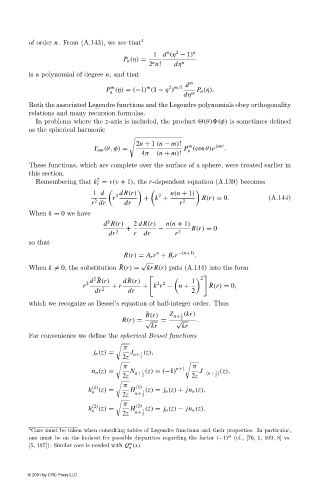Page 511 - Electromagnetics
P. 511
of order n. From (A.143), we see that 4
2
n
1 d (η − 1) n
P n (η) =
n
2 n! dη n
is a polynomial of degree n, and that
d m
m
2 m/2
m
P (η) = (−1) (1 − η ) P n (η).
n
dη m
Both the associated Legendre functions and the Legendre polynomials obey orthogonality
relations and many recursion formulas.
In problems where the z-axis is included, the product %(θ)#(φ) is sometimes defined
as the spherical harmonic
$
2n + 1 (n − m)! m jmθ
Y nm (θ, φ) = P (cos θ)e .
n
4π (n + m)!
These functions, which are complete over the surface of a sphere, were treated earlier in
this section.
2
Remembering that k = ν(ν + 1), the r-dependent equation (A.139) becomes
r
1 d 2 dR(r) 2 n(n + 1)
r + k + R(r) = 0. (A.144)
2
r dr dr r 2
When k = 0 we have
2
d R(r) 2 dR(r) n(n + 1)
+ − R(r) = 0
dr 2 r dr r 2
so that
n
R(r) = A r r + B r r −(n+1) .
√
¯
When k = 0, the substitution R(r) = kr R(r) puts (A.144) into the form
2
2 ¯
¯
d R(r) d R(r) 2 2 1
¯
2
r + r + k r − n + R(r) = 0,
dr 2 dr 2
which we recognize as Bessel’s equation of half-integer order. Thus
¯
R(r) Z n+ 1 (kr)
R(r) = √ = √ 2 .
kr kr
For convenience we define the spherical Bessel functions
)
π
j n (z) = J 1 (z),
2z n+ 2
) )
π n+1 π
1 (z),
n n (z) = N 1 (z) = (−1) J −(n+ )
2z n+ 2 2z 2
)
π
(1) (1)
h (z) = H 1 (z) = j n (z) + jn n (z),
n
2z n+ 2
)
π
(2) (2)
h (z) = H 1 (z) = j n (z) − jn n (z).
n
2z n+ 2
4 Care must be taken when consulting tables of Legendre functions and their properties. In particular,
one must be on the lookout for possible disparities regarding the factor (−1) m (cf., [76, 1, 109, 8] vs.
m
[5, 187]). Similar care is needed with Q (x).
n
© 2001 by CRC Press LLC

